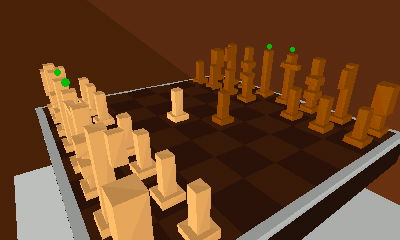This application was designed specifically to teach the idea of 3D game design. While this engine was built with simplicity in mind, it was also built to maximize efficiency and minimize the computation required to display good looking graphics. With that said this is an excellent engine to make 3D games, I don't ask for any credit, and anyone can use this program for their own purposes.
Use the comment section below for help, or if you have any questions, I'll be glad to help!
To see the power of SIM.3D, I added some regular demos that will give a better idea on how to use SIM.3D. The files include:
Doing so will load the 3D engine into program slot 3, then insert the code from program slot 0 into program slot 3, then execute itself.
the full documentation of SIM.3D
The most basic application to rotate a cube in the center of the screen is as follows:
PRGEDIT 3 EXEC "PRG3:3D.ENGINE" END 'S1M.3D
VAR C=ADDCUBE(0,0,0,1,1,1,#GRAY)
'C CONTAINS A REFERENCE TO THE CUBE
@LOOP
VSYNC 'STABALIZE THE FRAMERATE
ROTOBJ C,0,1,0 'ROTATE THE CUBE AROUND THE Y AXIS
RENDER 'RENDER THE WORLD
GOTO @LOOP 'REPEAT
There are a few things to be aware of before diving into the 3D engine
- One in-world unit is the equivalent of 50 pixels from the default camera position. Adding a scale definition like this makes the game feel more realistic. This can be customized by changing the WSC (world scaling constant) variable.
- When working with SIM.3D, you must work in the default program slot 0, you will need to save every time you run the code. Any errors can be traced to your code in program slot 3 where the actual engine is.
- Or you could work directly in the 3D engine and avoid the use of the loader. There's a spot in the beginning of the code dedicated for user programs to go.
- Every object is composed of triangles. If a triangle is defined clockwise then it will be visible from the outside of the object. There are preset objects to make this easier to work with.
- So triangles can only be seen from one side (for higher performance), using STRETCHOBJ with negative values to stretch an object inside-out will let you see the object's back faces instead of front
- Every object is given an index. This index will never change until the object is deleted, in which case the ID will be given to the next future object to be defined.
Engine variables:VAR CAMX,CAMY,CAMZ 'THE FOCUS POSITION OF THE CAMERA (DEFAULT: 0,0,0)
VAR CAMRX,CAMRY,CAMRZ 'ROTATION OF THE CAMERA (IN DEGREES) AROUND THE CAMERA FOCUS (DEFAULT: 0,20,0)
VAR CAMDIST 'DISTANCE AWAY FROM CAMERA'S FOCUS POINT (DEFAULT: 10)
VAR FOV 'FIELD OF VIEW (DEFAULT: 5)
VAR WSC 'WORLD SCALING CONSTANT IN PIXELS (DEFAULT: 50)
VAR CUTOFF_RATIO 'THE RATIO BETWEEN CAMERA AND FOCUS IN WHICH THINGS STOP RENDERING (DEFAULT: 0.7)
VAR BOUNDCAMANGLES 'TRUE/FALSE, TELL IF THE CAMERA SHOULD BE BOUNDED BETWEEN -180 AND 180 (DEFAULT: 1)
VAR RENDERDIST 'HOW FAR THE PLACER CAN SEE, 0=INFINITE (DEFAULT: 0)
VAR ACCELERATED_RENDERING 'TRUE/FALSE TO USE ADVANCED SOUND DLC (DEFAULT: 1 IF POSSIBLE)
VAR FPS 'FRAMES PER SECOND
VAR GMW0,GMH0 'WHERE THE SCREEN STARTS (DEFAULT: 0,0)
VAR GMW1,GMH1 'WHERE THE SCREEN ENDS (DEFAULT: 400,240)
VAR GMW05,GMH05 'DEFINES THE CENTER OF THE SCREEN TO SAVE COMPUTATIONAL OVERHEAD
Here are the preset object definitions:ADDCUBE(X,Y,Z,LENGTH,WIDTH,HEIGHT,COLOR)
'CREATE A RECTANGULAR PRISM, RETURN ITS INDEX
ADDWCUBE(X,Y,Z,LENGTH,WIDTH,HEIGHT,COLOR)
'CREATE A WIREFRAME RECTANGULAR PRISM, RETURN ITS INDEX
ADDSPHERE(X,Y,Z,RADIUS,COLOR)
'CREATE A SPHERE, RETURN ITS INDEX
ADDLINE(X1,Y1,Z1,X2,Y2,Z2,COLOR)
'CREATE A LINE, RETURN ITS INDEX
ADDPYRAMID(X,Y,Z,WIDTH,HEIGHT,COLOR)
'CREATE A SQUARE PYRAMID, WHERE THE BASE OF THE BOTTOM IS X,Y,Z
'RETURNS THE OBJECT'S INDEX
ADDDIAMOND(X,Y,Z,WIDTH,HEIGHT,COLOR)
'CREATE A DIAMOND SHAPE (A.K.A OCTAHEDRON)
'RETURNS THE OBJECT'S INDEX
ADDCRYSTAL(X,Y,Z,WIDTH,HEIGHT,COLOR)
'CREATE A DIFFERENT TYPE OF "DIAMOND" SHAPE
'RETURNS THE OBJECT'S INDEX
ADDSKYBOX(X,Y,Z,LENGTH,WIDTH,HEIGHT,COLOR)
'CREATE AN INSIDE-OUT CUBE THAT ACTS AS A SKYBOX WHEN LARGE
'RETURNS THE OBJECT'S INDEX
ADDSURFACE(X,Y,Z,GRIDX,GRIDY,LENGTH,WIDTH,COLOR)
'CREATE A FLAT GRID PLANE THAT CAN HAVE MATH EQUATIONS APPLIED TO IT
'RETURNS ITS INDEX
ADDFLAG(X,Y,Z,COLOR)
'CREATE A FLAG CHARACTER OBJECT (FROM 3D PARKOUR)
'RETURNS ITS INDEX
ADDTEXT X,Y,Z,TEXT$,COLOR
'MAKE A TEXT OBJECT IN THE WORLD
'RETURNS THE OBJECT'S INDEX
You may also consider defining your own objectADDOBJ(TYPE$,X[],Y[],Z[],COLOR)
'X[],Y[],Z[] DEFINE EACH TRIANGLE. THESE ARRAYS MUST BE IN SETS OF 3, SO LENGTH=3,6,9,12,15,18,...
Every object contains these variables:OBJX 'CENTER OF MASS X POSITION
OBJY 'CENTER OF MASS Y POSITION
OBJZ 'CENTER OF MASS Z POSITION
OBJTEXT$ 'A STRING (USED IN TEXT OBJECTS)
OBJTAG$ 'A STRING
ONJTYPE$ 'A STRING TELLING WHAT TYPE OF OBJECT IT IS
OBJINDEX 'THE INDEX POINTING TO WHICH TRIANGLES BELONG TO THIS OBJECT
OBJLENGTH 'THE LENGTH OF HOW MANY TRIANGLES BELONG TO THIS OBJECT
OBJRX 'GET (NO SET) THE OBJECT'S X ROTATION
OBJRY 'GET (NO SET) THE OBJECT'S Y ROTATION
OBJRZ 'GET (NO SET) THE OBJECT'S Z ROTATION
OBJSX 'GET (NO SET) THE OBJECT'S X SCALE (WIDTH)
OBJSY 'GET (NO SET) THE OBJECT'S Y SCALE (HEIGHT)
OBJRZ 'GET (NO SET) THE OBJECT'S Z SCALE (LENGTH)
OBJMINX 'GET (NO SET) THE OBJECT'S MINIMUM X VALUE
OBJMINY 'GET (NO SET) THE OBJECT'S MINIMUM Y VALUE
OBJMINZ 'GET (NO SET) THE OBJECT'S MINIMUM Z VALUE
OBJMAXX 'GET (NO SET) THE OBJECT'S MAXIMUM X VALUE
OBJMAXY 'GET (NO SET) THE OBJECT'S MAXIMUM Y VALUE
OBJMAXZ 'GET (NO SET) THE OBJECT'S MAXIMUM Z VALUE
OBJVX 'THE OBJECT'S X VELOCITY
OBJVY 'THE OBJECT'S Y VELOCITY
OBJVZ 'THE OBJECT'S Z VELOCITY
OBJVISSTATIC 'TRUE/FALSE, IF THE OBJECT IS AFFECTED BY PHYSICS
OBJMASK 'WHEN YOU DEFINE AN OBJECT YOU ARE GIVEN A MASK INDEX WHICH WILL NEVER
'CHANGE, SO YOU CAN ONLY ACCESS THE VARIABLES ABOVE BY GOING THROUGH THE OBJECT MASK
'FIRST:
OBX[OBJMASK[MY_OBJECT_INDEX]]=FOO
'BY USING THIS MASK, WE CAN GUARANTEE THAT AN OBJECT INDEX WILL NEVER CHANGE
'EVEN IF OBJECTS BEFORE IT ARE DELETED.
Here is a list of object functionsSTRETCHOBJ INDEX,SCALEX,SCALEY,SCALEZ
'SQUISHES OR STRETCHES AN OBJECT'S POINTS BY A GIVEN SCALE
MOVEOBJ INDEX,DX,DY,DZ
'INCREMENT AN OBJECT'S POSITION RELATIVE TO ITS CURRENT POSITION
MOVEOBJTO INDEX,X,Y,Z
'TELEPORT AN OBJECT SOMEWHERE (NOT RELATIVE)
ROTOBJ INDEX,AX,AY,AZ
'INCREMENT THE ROTATION OF AN OBJECT AROUND ITS CENTER OF MASS RELATIVE TO ITS CURRENT ROTATION
ROTOBJTO INDEX,AX,AY,AZ
'SET THE ROTATION OF AN OBJECT AROUND ITS CENTER OF MASS (NOT RELATIVE)
'THIS WILL RESET THE OBJECT'S ROTATION TO ITS DEFAULT, THEN ROTATE IT AX,AY,AZ
ROTOBJAROUND INDEX,X,Y,Z,AX,AY,AZ
'ROTATE AN OBJECT AROUND (X,Y,Z)
ROTOBJAROUNDOBJ INDEX,INDEX2,AX,AY,AZ
'ROTATE AN OBJECT AROUND ANOTHER OBJECT
ROTOBJTOPOINT INDEX,X,Y,Z
'ROTATE AN OBJECT SO THAT IT FACES THE POINT X,Y,Z
MERGEOBJS(INDEX1,INDEX2)
'MERGE TWO OBJECTS INTO ONE, RETURNS THE NEW INDEX
SPLITOBJ INDEX,TRIANGLES OUT INDEX1,INDEX2
'SPLIT AN OBJECT AT A TRIANGLE INDEX, DEFINING THE AMOUNT OF TRIANGLES FOR THE FIRST OBJECT
DELOBJ INDEX : INDEX=-1
'DELETE AN OBJECT FROM THE WORLD
'THEN IT IS RECOMMENDED TO SET THE INDEX TO -1
CHANGEOBJCOLOR INDEX,COLOR
'SET AN OBJECT'S COLOR
CHANGEOBJFACECOLOR INDEX,FACE,COLOR
'SET THE COLOR OF A SINGLE TRIANGLE ON AN OBJECT
CHANGEOBJCOLORAB OBJECT,INDEX1,INDEX2,COLOR
'SET AN OBJECT'S COLOR FROM INDEX1 TO INDEX2 INSIDE THE OBJECT
'OBJECT TRIANGLE INDEXES START AT 0 FOR EACH OBJECT
SETTAG INDEX,TAG$
'GIVE AN OBJECT A STRING, DEFAULT=""
'THIS CAN BE ANYTHING, IT DOESN'T AFFECT THE 3D ENGINE AT ALL
'DESIGNED TO BE USED BY THE DEVELOPER
GETTAG$(INDEX)
'GET THE TAG$ VALUE OF AN OBJECT
FINDIBJBYTAG(TAG$)
'QUICKLY FIND AN OBJECT WITH A SPECIFIC TAG$ VALUE
'RETURNS -1 IF NO OBJECT EXISTS WITH THIS TAG
SETSTR INDEX,S$
'GIVE AN OBJECT A STRING, DEFAULT=""
'THIS IS USED TO STORE THE VALUE IN TEXT OBJECTS
'THERE IS NO USE OUTSIDE OF TEXT OBJECTS, SO THIS IS ANOTHER FREE VARIABLE
GETSTR$(INDEX)
'GET THE STRING VALUE OF AN OBJECT
FINDIBJBYSTR(S$)
'FIND AN OBJECT WITH A SPECIFIC STRING$ VALUE
'RETURNS -1 IF NO OBJECT EXISTS WITH THIS STRING
'OTHERWISE RETURN THE OBJECT INDEX
GETOBJTYPE$(INDEX)
'RETURNS THE STRING DEFINING WHAT TYPE OF OBJECT IT IS
'POSSIBLE RESULTS ARE:
"CUBE","SPHERE","DIAMOND","CRYSTAL","PYRAMID","SKYBOX","LINE","SURFACE","TEXT",etc...
GETOBJSBYDIST(X,Y,Z)
'RETURNS A SORTED ARRAY OF OBJECT INDEXES SUCH THAT THE FIRST ITEM IS CLOSEST
'TO (X,Y,Z) AND THE LAST ITEM IS FURTHEST AWAY FROM (X,Y,Z)
'THIS FUNCTION TAKES ADVANTAGE OF DLC USERS TO GIVE MUCH FASTER PERFORMANCE
UPDATEWCUBEAROUNDOBJ INDEX1,INDEX2
'CHANGE THE WIREFRAME CUBE OBJECT INSIDE INDEX1 TO THE SAME SHAPE AND
'SIZE OF THE OBJECT INSIDE INDEX2 (INDEX1 MUST BE A WCUBE OBJECT)
'IN OTHER WORDS, THIS IS AN ADD-ON TO THE WCUBE OBJECT TO ALLOW IT TO
'PERFECTLY MASK THE BOUNDING BOX OF ANOTHER OBJECT
APPLYSURFACEEQUATION INDEX,EQU$,MINY,MAXY,SCX,SCY,SCZ
'APPLY A MATH EXPRESSION TO A SURFACE OBJECT
'EQU$ IS AN EQUATION WITH X,Y, AND Z IN IT
'EQU$="SIN(X)+COS(Z)" MAKES A WAVY SURFACE
'MINY AND MAXY DEFINE THE OBJECT'S Y BOUNDS
'SCX,SCY,SCZ ARE THE ZOOM FACTORS, 0.1=>10X ZOOM
'IN OTHER WORDS, THIS IS AN ADD-ON TO SURFACES, ALLOWING
'THEM TO TAKE ON THE FORM OF ANY EQUATION
GETUNMASKEDINDEX(MASKEDINDEX)
'SAME AS SAYING OBJMASK[MASKEDINDEX]
'CONVERTS A STABLE OBJECT ID (THAT DOESN'T CHANGE) INTO
'THE ACTUAL INDEX USED IN OBJX,OBJY,OBJZ,OBJROT,etc...
UPDATEOBJCENTER INDEX
'UPDATES THE CENTER OF MASS OF AN OBJECT (DONE AUTOMATICALLY)
SETSTATICOBJ INDEX,STATE
'SET IF AN OBJECT IS AFFECTED BY GRAVITY AND COLLISIONS
'STATE IS EITHER 1 OR 0 (WHERE 0=AFFECTED BY GRAVITY)
ADDVEL INDEX,VX,VY,VZ
'ADD VELOCITY TO A NON-STATIC OBJECT
'YOU COULD ALSO JUST DO:
'INC OBJVX[OBJMASK[INDEX]],VX
'INC OBJVY[OBJMASK[INDEX]],VY
'INC OBJVZ[OBJMASK[INDEX]],VZ
And a few other functions, slightly unrelated, but implemented nonetheless:RENDER
'DRAWS THE CURRENT WORLD STATE, REQUIRED TO RUN ONCE EVERY FRAME
BUFFER
'PREVENTS FLICKERING BY SWAPPING GPAGES EACH FRAME, DRAWING TO THE ONE NOT
'BEING SHOWN. THIS SHOULD BE RAN ONCE EVERY FRAME, WITH A GCLS DIRECTLY AFTER IT
'THIS ONLY AFFECTS THE TOP SCREEN
'THIS IS AUTOMATICALLY CALLED INSIDE RENDER
_RENDER
'RENDERS THE SCENE WITHOUT CALLING BUFFER AND CLEARING THE SCREEN
BUFFERBOTTOM
'PREVENT FLICKERING ON THE LOWER SCREEN, PUT GCLS DIRECTLY AFTER IT
GETCAMRAY OUT X,Y,Z
'RETURNS THE NORMALIZED DIRECTION THE CAMERA IS FACING
GETCAMRAY2D OUT X,Z
'RETURNS THE NORMALIZED DIRECTION THE CAMERA IS FACING EXCLUDING Y
RAYTHROUGHOBJ(X,Y,Z,RX,RY,RZ,INDEX)
'CHECK IF THE RAY STARTING AT X,Y,Z AT THE ANGLE RX,RY,RZ
'IS COLLIDING WITH THE OBJECT INSIDE INDEX
NORMALIZE X,Y,Z OUT X,Y,Z
'SET THE DISTANCE OF AN X,Y,Z DISPLACEMENT EQUAL TO 1
'WHILE MAINTAINING THE ANGLE
CLEARWORLD
'DELETES EVERYTHING IN THE WORLD
'TRIANGLE OPERATION FUNCTIONS
ADDTRI INDEX,TAG$,X1,Y1,Z1,X2,Y2,Z2,X3,Y3,Z3,COLOR
SETTRI INDEX,X1,Y1,Z1,X2,Y2,Z2,X3,Y3,Z3 'SET A TRIANGLES POSITION
DELTRI TRIANGLEINDEX 'DELETE A TRIANGLE
SPLITSCREENDRAW X1,Y1,Z1,RX1,RY1,RZ1,X2,Y2,Z2,RX2,RY2,RZ2
'REPLACES THE RENDER FUNCTION
'DRAWS TWO PERSPECTIVES FROM TWO CAMERA POSITIONS AND ANGLES
'[ UNDER CONSTRUCTION, STILL A BIT BUGGY ]
QUADRUPLEDRAW X1,Y1,Z1,RX1,RY1,RZ1,X2,Y2,Z2,RX2,RY2,RZ2,X3,Y3,Z3,RX3,RY3,RZ3,X4,Y4,Z4,RX4,RY4,RZ4
'REPLACES THE RENDER FUNCTION
'DRAWS FOUR PERSPECTIVES FROM FOUR CAMERA POSITIONS AND ANGLES
'3D POINT ROTATION FUNCTIONS
ROT X,Y,Z,ORIGINX,ORIGINY,ORIGINZ,ANGLEX,ANGLEY,ANGLEZ OUT X,Y,Z
ROTX X,Y,Z,ANGLE OUT X,Y,Z 'ROTATE A POINT JUST AROUND X AXIS
ROTY X,Y,Z,ANGLE OUT X,Y,Z 'ROTATE A POINT JUST AROUND Y AXIS
ROTZ X,Y,Z,ANGLE OUT X,Y,Z 'ROTATE A POINT JUST AROUND Z AXIS
INSERT ARRAY[],INDEX,VALUE 'QUICKLY INSERT AN ELEMENT INTO AN ARRAY
REMOVE ARRAY[],INDEX 'QUICKLY REMOVE AN ELEMENT FROM AN ARRAY
TRIM$(S$) 'REMOVE SPACES AND NEW LINES FROM THE FRONT AND END OF A STRING
'HSV OPERATIONS
HSV2RGB HUE,SATURATION,VALUE OUT RED,GREEN,BLUE
RGB2HSV RED,GREEN,BLUE OUT HUE,SATURATION,VALUE
HSV(HUE,SATURATION,VALUE)
'RETURNS THE COLOR AS A SINGLE NUMBER, JUST LIKE RGB(R,G,B) DOES
FCIRCLE X,Y,RADIUS,FILLCOLOR,BORDERCOLOR
'DRAW A FILLED CIRCLE
TEXT X,Y,TEXT$,COLOR
'DRAW CENTERED TEXT ON THE SCREEN
PERSPECTIVE X,Y,Z OUT X,Y,Z
'CONVERT IN-WORLD COORDINATES TO SCREEN COORDINATES
PERSPECTIVEZ(X,Y,Z)
'QUICKLY JUST CALCULATE THE Z VALUE AFTER PERSPECTIVE
ARYOP_PERSPECTIVE X[],Y[],Z[] OUT X[],Y[],Z[]
'CALCULATE FASTER PERSPECTIVE
some examples of SIM.3D usage
Four cubes with one smaller one orbiting around it, supports moving the camera using the circle padPRGEDIT 3 EXEC "PRG3:3D.ENGINE" END 'SIM.3D
VAR STX,STY,C
'POSITION (0,0,0) SIZE (1,1,1)
C=ADDCUBE(0,0,0,1,1,1,#GRAY)
C=ADDCUBE(0,1.5,0,1,1,1,#GREEN)
C=ADDCUBE(1.5,0,0,1,1,1,#CYAN)
C=ADDCUBE(0,0,1.5,1,1,1,#WHITE)
C=ADDCUBE(0,0,3,0.5,0.5,0.5,HSV(0,255,255))
'THE VARIABLE C WAS OVERWRITTEN OVER AND OVER, BUT THIS ONE WE'LL KEEP
@LOOP
VSYNC
STICK OUT STX,STY
'CAMRX,CAMRY ARE USED BY SIM.3D
CAMRX=CAMRX-STX*5
CAMRY=CAMRY-STY*5
'ROTATE THE CUBE AROUND THE POINT (0,0,0) ROTATING AROUND THE X AND Y AXIS
ROTOBJAROUND C,0,0,0,1,1,0
RENDER
GOTO @LOOP
 You are a cube, you can rotate your camera and move around the world. In the world there is a large 3D Sierpinski tetrahedron fractal generated recursively
You are a cube, you can rotate your camera and move around the world. In the world there is a large 3D Sierpinski tetrahedron fractal generated recursivelyPRGEDIT 3 EXEC "PRG3:3D.ENGINE"
VAR I,J
'MAKE AN INSIDE OUT CUBE CENTERED AT POSITION (0,5,50) AND SIZE (120,120,120)
I=ADDSKYBOX(0,5,50,120,120,120,RGB(60,60,60))
VAR PLAYER=ADDCUBE(0,0,0,1,1,1,#WHITE)
VAR BTN,STX,STY,X,Y,Z
'CALL THE FUNCTION THAT GENERATES THE FRACTAL
'POSITION=(0,30,50)
'SIZE=(40,50)
'DEPTH=3
'(HUE,SATURATION,VALUE)=(RND(360),150,255)
SIERPINSKI 0,30,50,40,50,3,RND(360),150,255
@LOOP
VSYNC
CLS
PRINT "FPS ";FPS 'FPS IS CALCULATED INSIDE SIM.3D
'EVERY FRAME, SET THE PLAYER CUBE TO THE SAME POSITION AS THE CAMERA
MOVEOBJTO PLAYER,CAMX,CAMY,CAMZ
CONTROLS 'CALL THE FUNCTION THAT HANDLES CONTROLS
'PREVENT THE CAMERA FROM GOING UPSIDE DOWN
IF CAMRY<-90 THEN CAMRY=-90
IF CAMRY>90 THEN CAMRY=90
RENDER 'CALL THE RENDER FUNCTION IN SIM.3D
GOTO @LOOP
'HANDLE DEVICE CONTROLS
DEF CONTROLS
STICK OUT STX,STY 'CIRCLE PAD INPUT
BTN=BUTTON() 'INPUT FOR BUTTONS
'ROTATE THE CAMERA, USE COSINE TO ENSURE IT IS ALIGNED
DEC CAMRX,STX*6*COSCAMRZ
DEC CAMRY,STY*6*COSCAMRZ
IF BTN AND #UP THEN CAMDIST=CAMDIST/1.05 'ZOOMING IN/OUT
IF BTN AND #DOWN THEN CAMDIST=CAMDIST*1.05
IF BTN AND #X THEN 'MOVING FORWARD
VAR X,Y,Z
GETCAMRAY OUT X,Y,Z 'THIS WILL GIVE THE X,Y,Z UNIT ROTATION FACING OUT OF THE CAMERA
INC CAMX,X/2 'INCREMENT THE CAMERA POSITION
INC CAMY,Y/2
INC CAMZ,Z/2
ENDIF
IF BTN AND #B THEN 'MOVING BACKWARD
VAR X,Y,Z
GETCAMRAY OUT X,Y,Z 'THIS WILL GIVE THE X,Y,Z UNIT ROTATION FACING OUT OF THE CAMERA
DEC CAMX,X/2 'DECREMENT THE CAMERA POSITION
DEC CAMY,Y/2
DEC CAMZ,Z/2
ENDIF
END
'GENERATE A SIERPINSKI TETRAHEDRON FRACTAL
'POSITION=(X,Y,Z)
'SIZE=(WIDTH,HEIGHT) (LENGTH ISN'T INCLUDED SINCE ITS A SQUARE BASE)
'DEPTH IS HOW MANY ITERATIONS TO GO IN (PERFORMANCE TAKES A HUGE HIT, INCREMENTING)
'COLOR=(HUE,SATURATION,VALUE)
DEF SIERPINSKI X,Y,Z,W_,H_,DEPTH,HU,SA,VA
VAR I,W=W_*0.5,H=H_*0.5
IF DEPTH==0 THEN 'BASE CASE
I=ADDPYRAMID(X,Y,Z,W_*2,H_,HSV(HU,SA,VA))
ELSE
SIERPINSKI X,Y-H,Z,W,H,DEPTH-1,HU+100,SA,VA
SIERPINSKI X-W,Y,Z-W,W,H,DEPTH-1,HU,SA,VA
SIERPINSKI X-W,Y,Z+W,W,H,DEPTH-1,HU,SA,VA
SIERPINSKI X+W,Y,Z-W,W,H,DEPTH-1,HU,SA,VA
SIERPINSKI X+W,Y,Z+W,W,H,DEPTH-1,HU,SA,VA
ENDIF
END


 Perhaps this would be even faster if the on screen position of a vertex wasn't calculated multiple times when it's used by multiple triangles...
Perhaps this would be even faster if the on screen position of a vertex wasn't calculated multiple times when it's used by multiple triangles...


